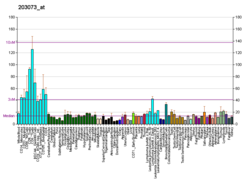Protein-coding gene in the species Homo sapiens
| COG2 |
|---|
|
| Identifiers |
|---|
| Aliases | COG2, LDLC, component of oligomeric golgi complex 2, CDG2Q |
|---|
| External IDs | OMIM: 606974; MGI: 1923582; HomoloGene: 7206; GeneCards: COG2; OMA:COG2 - orthologs |
|---|
| Gene location (Human) |
|---|
 | | Chr. | Chromosome 1 (human)[1] |
|---|
| | Band | 1q42.2 | Start | 230,642,481 bp[1] |
|---|
| End | 230,693,982 bp[1] |
|---|
|
| Gene location (Mouse) |
|---|
 | | Chr. | Chromosome 8 (mouse)[2] |
|---|
| | Band | 8|8 E2 | Start | 125,247,506 bp[2] |
|---|
| End | 125,278,747 bp[2] |
|---|
|
| RNA expression pattern |
|---|
| Bgee | | Human | Mouse (ortholog) |
|---|
| Top expressed in | - rectum
- right hemisphere of cerebellum
- right adrenal cortex
- pancreatic ductal cell
- islet of Langerhans
- gonad
- left adrenal gland
- left adrenal cortex
- granulocyte
- tibialis anterior muscle
|
| | Top expressed in | - yolk sac
- lens
- granulocyte
- spermatocyte
- right kidney
- neural layer of retina
- epithelium of stomach
- muscle of thigh
- proximal tubule
- spermatid
|
| | More reference expression data |
|
|---|
| BioGPS |  | | More reference expression data |
|
|---|
|
| Gene ontology |
|---|
| Molecular function | - protein binding
- protein-containing complex binding
| | Cellular component | - Golgi transport complex
- cytosol
- Golgi membrane
- Golgi stack
- Golgi apparatus
- membrane
- trans-Golgi network membrane
| | Biological process | - protein transport
- endoplasmic reticulum to Golgi vesicle-mediated transport
- intra-Golgi vesicle-mediated transport
- Golgi organization
| | Sources:Amigo / QuickGO |
|
| Orthologs |
|---|
| Species | Human | Mouse |
|---|
| Entrez | | |
|---|
| Ensembl | | |
|---|
| UniProt | | |
|---|
| RefSeq (mRNA) | | |
|---|
| RefSeq (protein) | | |
|---|
| Location (UCSC) | Chr 1: 230.64 – 230.69 Mb | Chr 8: 125.25 – 125.28 Mb |
|---|
| PubMed search | [3] | [4] |
|---|
|
| Wikidata |
| View/Edit Human | View/Edit Mouse |
|
Conserved oligomeric Golgi complex subunit 2 is a protein that in humans is encoded by the COG2 gene.[5][6]
Multiprotein complexes are key determinants of Golgi apparatus structure and its capacity for intracellular transport and glycoprotein modification. Several complexes have been identified, including the Golgi transport complex (GTC), the LDLC complex, which is involved in glycosylation reactions, and the SEC34 complex, which is involved in vesicular transport. These 3 complexes are identical and have been termed the conserved oligomeric Golgi (COG) complex, which includes COG2 (Ungar et al., 2002).[6]
Interactions
COG2 has been shown to interact with COG4[7] and COG3.[8]
References
- ^ a b c GRCh38: Ensembl release 89: ENSG00000135775 – Ensembl, May 2017
- ^ a b c GRCm38: Ensembl release 89: ENSMUSG00000031979 – Ensembl, May 2017
- ^ "Human PubMed Reference:". National Center for Biotechnology Information, U.S. National Library of Medicine.
- ^ "Mouse PubMed Reference:". National Center for Biotechnology Information, U.S. National Library of Medicine.
- ^ Podos SD, Reddy P, Ashkenas J, Krieger M (Dec 1994). "LDLC encodes a brefeldin A-sensitive, peripheral Golgi protein required for normal Golgi function". J Cell Biol. 127 (3): 679–91. doi:10.1083/jcb.127.3.679. PMC 2120235. PMID 7962052.
- ^ a b "Entrez Gene: COG2 component of oligomeric golgi complex 2".
- ^ Loh, Eva; Hong Wanjin (Jun 2004). "The binary interacting network of the conserved oligomeric Golgi tethering complex". J. Biol. Chem. 279 (23): 24640–8. doi:10.1074/jbc.M400662200. ISSN 0021-9258. PMID 15047703.
- ^ Loh, Eva; Hong Wanjin (Jun 2002). "Sec34 is implicated in traffic from the endoplasmic reticulum to the Golgi and exists in a complex with GTC-90 and ldlBp". J. Biol. Chem. 277 (24): 21955–61. doi:10.1074/jbc.M202326200. ISSN 0021-9258. PMID 11929878.
External links
Further reading
- Salesiotis AN, Wang CK, Wang CD, et al. (1995). "Identification of novel genes from stomach cancer cell lines by differential display". Cancer Lett. 91 (1): 47–54. doi:10.1016/0304-3835(95)03717-B. PMID 7750094.
- Loh E, Hong W (2002). "Sec34 is implicated in traffic from the endoplasmic reticulum to the Golgi and exists in a complex with GTC-90 and ldlBp". J. Biol. Chem. 277 (24): 21955–61. doi:10.1074/jbc.M202326200. PMID 11929878.
- Ungar D, Oka T, Brittle EE, et al. (2002). "Characterization of a mammalian Golgi-localized protein complex, COG, that is required for normal Golgi morphology and function". J. Cell Biol. 157 (3): 405–15. doi:10.1083/jcb.200202016. PMC 2173297. PMID 11980916.
- Strausberg RL, Feingold EA, Grouse LH, et al. (2003). "Generation and initial analysis of more than 15,000 full-length human and mouse cDNA sequences". Proc. Natl. Acad. Sci. U.S.A. 99 (26): 16899–903. Bibcode:2002PNAS...9916899M. doi:10.1073/pnas.242603899. PMC 139241. PMID 12477932.
- Loh E, Hong W (2004). "The binary interacting network of the conserved oligomeric Golgi tethering complex". J. Biol. Chem. 279 (23): 24640–8. doi:10.1074/jbc.M400662200. PMID 15047703.
- Gerhard DS, Wagner L, Feingold EA, et al. (2004). "The status, quality, and expansion of the NIH full-length cDNA project: the Mammalian Gene Collection (MGC)". Genome Res. 14 (10B): 2121–7. doi:10.1101/gr.2596504. PMC 528928. PMID 15489334.
- Rual JF, Venkatesan K, Hao T, et al. (2005). "Towards a proteome-scale map of the human protein-protein interaction network". Nature. 437 (7062): 1173–8. Bibcode:2005Natur.437.1173R. doi:10.1038/nature04209. PMID 16189514. S2CID 4427026.
- Sohda M, Misumi Y, Yoshimura S, et al. (2007). "The interaction of two tethering factors, p115 and COG complex, is required for Golgi integrity". Traffic. 8 (3): 270–84. doi:10.1111/j.1600-0854.2006.00530.x. PMID 17274799.
















